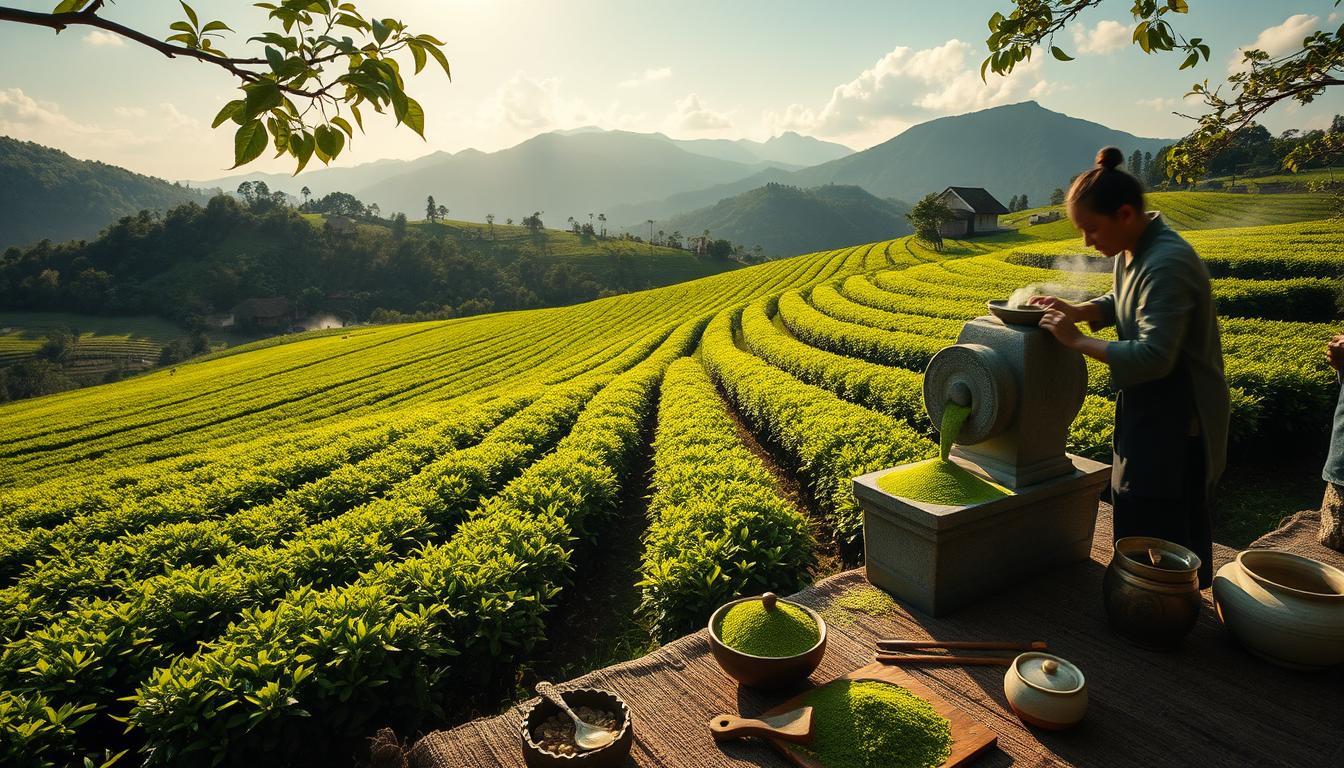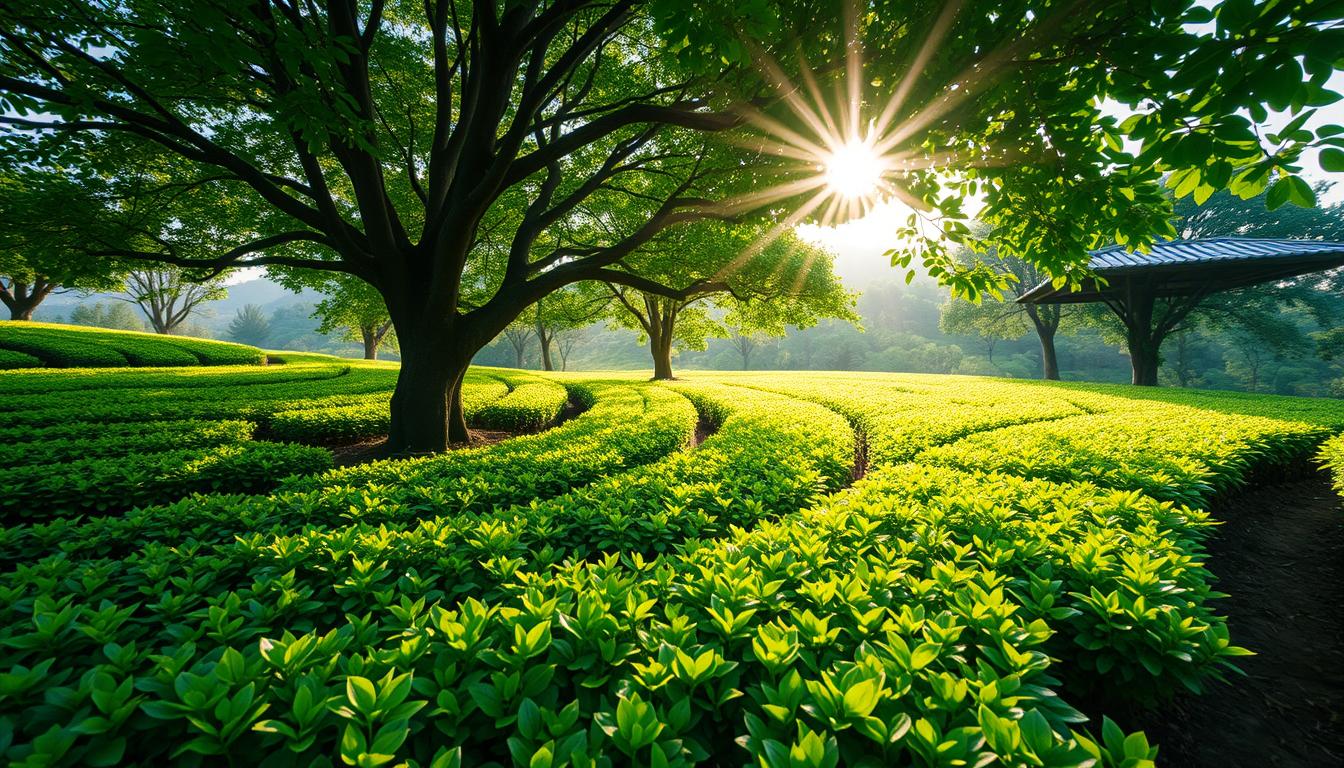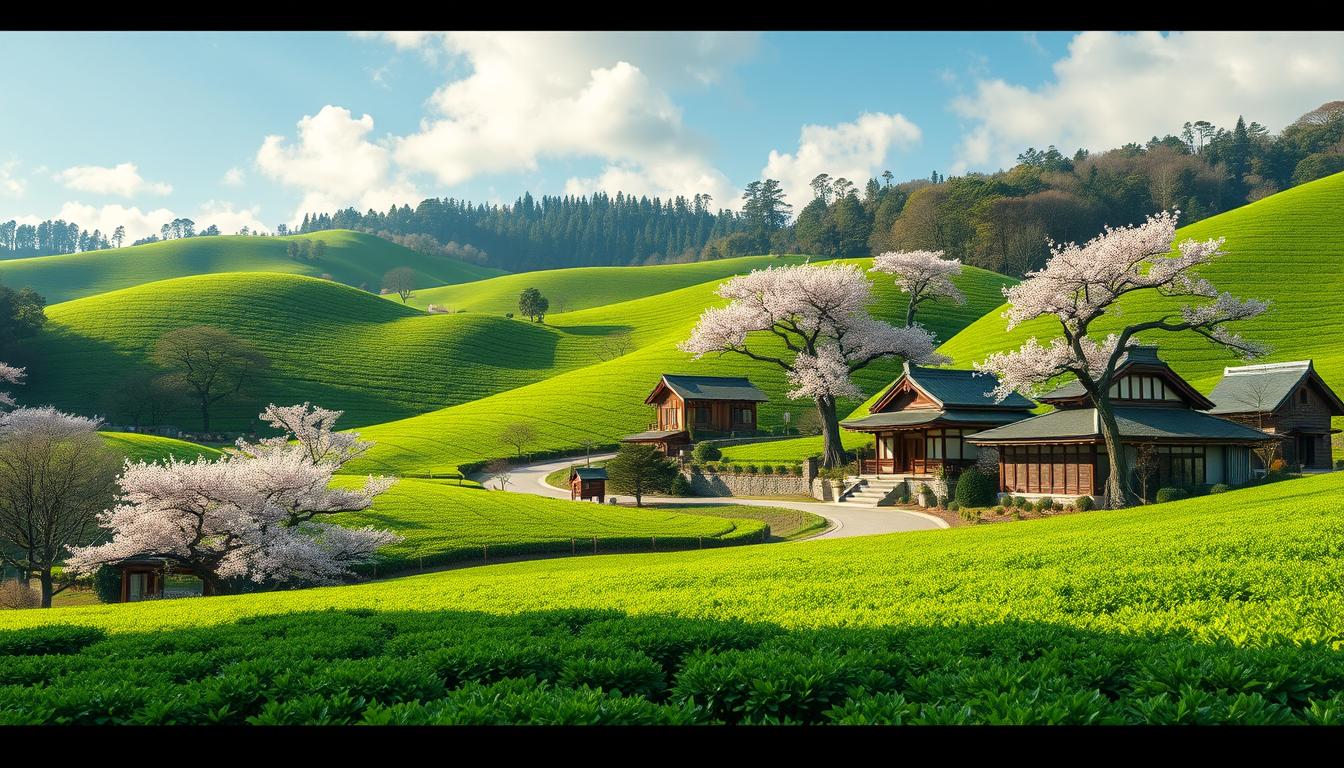Did you know over 97% of Nishio’s tea leaves are for matcha? Welcome to Matcha Village, a green tea paradise. Here, tea culture comes alive. Located in Nishio City, Japan, it offers a unique green tea experience.
Nishio has a long history of matcha, starting in 1271. It was loved by monks and the aristocracy. Now, Nishio’s matcha is famous worldwide, in many famous candies.
Matcha Village is special because of its old but precise ways of making matcha. SAIJOEN AIYA uses over 1300 handcrafted millstones. Each one grinds just 30-40g of matcha per hour. Visitors can try matcha experiences, like tea-picking in April and May.
They can also enjoy matcha treats in over 30 cafes. These cafes offer a real taste of this green tea paradise.
Key Takeaways
- Nishio dedicates over 97% of its tea leaves to matcha production.
- The city has nearly 800 years of matcha cultivation history.
- SAIJOEN AIYA’s millstones grind only 30-40g of matcha per hour.
- Visitors can experience tea-picking dressed in traditional attire.
- Over 30 local cafes offer exquisite matcha desserts and signatures.
Understanding the Allure of Matcha
Matcha has become a worldwide favorite. It’s known for its bright green color, unique taste, and health perks. It’s a big part of Japanese tea culture, thanks to careful preparation.
Matcha’s history goes back to 805 AD. It was introduced to Japan by monk Saichō. Today, it’s key in Japanese tea ceremonies.
The Unique Preparation of Matcha
Preparing matcha is special in Japanese culture. The leaves grow under shade tarps for weeks. This makes them rich in chlorophyll and amino acids.
After harvesting, the leaves are steamed, dried, and ground. This makes the green tea powder we love. High-quality matcha, like Mizuba Tea Co.’s, comes from dedicated farmers.
Health Benefits of Matcha
Matcha is good for you in many ways. It’s full of catechins, like EGCG. These help reduce stress and promote calm.
Matcha also has caffeine and theanine. This mix gives energy without the usual coffee jitters. Professor Yuki Kurauchi says it boosts brain function and relaxation.
Matcha’s popularity has grown a lot. In the U.S., matcha use has increased by 100% in five years. It’s loved for its taste and health benefits.
More people are trying matcha in cafes and online. Online searches for matcha products have risen by 40%. Stores like Costco now sell high-quality matcha. This shows how popular it is today.
Visiting Uji, Japan, is a great way to learn about matcha. Uji is famous for its matcha and tea culture. For more on Uji, read this article.
The History of Matcha in Nishio
Matcha in Nishio has a long history, almost eight centuries old. It’s deeply connected to Japanese tea culture. Over time, it has shaped Nishio into a top matcha producer.
Origins and Early Cultivation
In 1271, Shoichi Kokushi planted tea trees at Jisso-ji Temple in Mikawa. The tea was first for monks and the elite. It quickly became famous for its quality and taste.
The Edo period saw Tokugawa Ieyasu support tea farming. This made Nishio a key place in Japanese tea culture.
Meiji Period Expansion
The Meiji period was big for Nishio’s matcha. Jundo Adachi brought new tea seeds and methods from Uji, Kyoto. This improved the tea’s quality.
Nishio focused on top teas like gyokuro and tencha. This made it stand out in Japanese tea culture.
Modern Matcha Production in Nishio
Today, Nishio is known for its matcha. Its climate and soil, near the Yahagi River, make the tea special. Most tea grown here is tencha.
Nishio matcha is loved worldwide. It’s used in many dishes, showing Japan’s tea culture.
The Day of Matcha was started in 1992. It celebrates Nishio Tea’s 120th year. It shows the community’s dedication to matcha.
| Nishio Matcha Facts | Details |
|---|---|
| Establishment Year | 1271 (by Shoichi Kokushi) |
| Main Cultivation Era | Meiji Period (1868 – 1912) |
| Primary Tea Type Grown | Tencha (over 90%) |
| Modern Prominence | 20% of Japan’s Matcha Production |
| Geographical Advantage | Near Yahagi River |
| Annual Celebration | Day of Matcha (Established 1992) |
Exploring Nishio: A Matcha Enthusiast’s Dream
If you love matcha, Nishio is your dream spot. This city is full of matcha attractions that will amaze you. You’ll see tea fields and matcha cafes everywhere, showing off Nishio’s matcha culture.
There are tours in Nishio that show you the city’s history and charm. These tours are great for learning about matcha.
Explore Nishio’s beautiful landscapes through matcha activities. The city has scenic cycling routes that are easy to follow. These routes are a hit with visitors.
Local Attractions and Activities
Nishio has many attractions and activities for matcha lovers. Check out the Nishio Tea Museum to learn about matcha’s history. You can also relax at tea houses and try matcha treats.
Take part in matcha workshops to learn how to whisk and grind matcha. It’s a fun way to get close to matcha.
Bicycle Tours and Scenic Rides
For active sightseers, try Nishio’s bike tours. These tours take you to tea farms and show you the city’s calm side. You can rent bikes easily and affordably to explore Nishio at your pace.
| Attraction | Description |
|---|---|
| Nishio Tea Museum | Discover the rich history and production techniques of matcha. |
| Bicycle Rentals | Affordable bike rentals for exploring Nishio’s scenic routes. |
| Matcha Workshops | Engage in hands-on matcha-related activities, from whisking to grinding. |
| Local Tea Houses | Experience traditional tea ceremonies and savor matcha delicacies. |
Artisanal Tea Makers and Their Practices
In Nishio, Japan, matcha making is a cherished tradition. It’s all about careful steps that show the beauty of artisanal matcha. Local tea experts make top-notch matcha that pleases even the pickiest eaters.

Traditional Methods of Matcha Production
Tea leaves are picked by hand, steamed, and dried before being ground. In Nishio, artisans use over 1300 millstones for a perfect powder. This hard work makes matcha taste amazing and look vibrant green.
The Role of Artisans in Matcha Craftsmanship
Matcha making is all about the skill of artisans. They use old ways learned from their families. Their work, like at SAIJOEN AIYA and Aoi Seicha, lets you see the beauty in every cup.
| Aspect | Artisanal Matcha Production | Mass-Produced Tea |
|---|---|---|
| Quality Focus | High | Low |
| Production Method | Manual and Skilled | Automated |
| Quantity | Limited | High |
| Environmental Considerations | Integral | Less Priority |
Matcha Village: A Green Tea Paradise
Welcome to Matcha Village, a place where green tea meets tradition. It’s in Japan’s heart, offering a unique matcha experience. Here, tea leaves grow in the shade, then become the famous matcha powder.
Matcha Village is more than just tea. It’s a place where you can see how tea leaves become matcha. This lets you see the hard work and care that goes into it.
Tea lovers, Matcha Village is for you. Places like Urth Cafe and Cha Cha Matcha in LA show its charm. It’s a green tea paradise in the US, showing matcha’s importance in Japan.
Matcha is loved for its taste and health benefits. An article from besttealeaves.com talks about its health perks. In Matcha Village, these benefits meet local traditions, creating a special mix of health and culture.
Visitors get to try many matcha experiences. From tea ceremonies to matcha desserts at Nakamura Tokichi Honten. These moments make your matcha journey unforgettable.
In the US, LA is a top spot for matcha lovers. Places like Alcove Los Angeles and Porto’s offer amazing matcha. They show Matcha Village’s dedication to quality and tradition.
Matcha Village is a place of green beauty and scents. It’s perfect for both matcha fans and newcomers. Here, you’ll find a journey of discovery, health, and joy.
Antioxidant-Rich Tea: The Benefits of Organic Matcha
Organic matcha is packed with health benefits. It’s full of catechins, which fight stress at a molecular level. Drinking organic matcha is not just tasty. It also boosts your health in many ways.
Catechins and Their Health Impacts
Matcha catechins are very powerful. They help keep your heart healthy by lowering bad cholesterol. They also might help prevent cancer by shrinking tumors and slowing cancer cell growth.
Matcha has 137 times more catechins than other green teas. This makes it a top source of these antioxidants.
Theanine’s Role in Relaxation and Cognitive Enhancement
Organic matcha is known for its high theanine levels. Theanine helps calm your mind and body. It can also improve your memory and learning skills.
This makes matcha great for boosting your brain power.
Caffeine Content and Its Benefits
Matcha’s caffeine is different from coffee’s. It gives you energy without the jitters. This energy lasts longer, helping you stay alert all day.
Matcha also has polyphenols. These protect your brain and might slow down brain aging.
Choosing organic matcha means getting a superfood. It’s full of antioxidants, supports relaxation, and gives you lasting energy. Matcha’s mix of catechins, theanine, and caffeine benefits your body and mind.
Understanding Ceremonial Grade Matcha
Ceremonial grade matcha is the top level of matcha, showing great care from start to finish. It has a long history in Japan, known for its bright color, soft taste, and fine texture.
In places like Uji, Kyoto, only 60 families make this special matcha. They work for three months, and it takes a year to make. Every leaf is picked by hand and steamed quickly to keep it fresh.
This matcha is made with great care. The leaves used are from the first harvest, picked for their taste. These leaves are picked once, making the matcha fresh and smooth.
Other matcha tastes bitter and is less smooth. Ceremonial grade matcha is bright green and tastes better. Matcha companies decide what to call their matcha, so try it before you buy.
The way the leaves are shaded before picking affects the taste. Longer shading and earlier picking make the leaves better. This makes ceremonial grade matcha more expensive, especially from places like Uji.
Knowing the difference between ceremonial and culinary matcha is important. Domatcha was the first in North America to call their matcha ceremonial. Ceremonial matcha is for drinking, showing off its rich flavors and textures.
The path from tea plant to ceremonial matcha is full of tradition and care. When you drink this tea, you’re joining a long-standing Japanese tradition.
Sustainable Farming Practices in Matcha Production
Sustainable matcha farming is key to making high-quality tea. Shade-grown matcha is a main method used. It involves shading the tea bushes for 20-30 days before harvest. This makes the leaves rich in chlorophyll, giving them a vibrant green color and a sweet taste.
The Importance of Shade Growing
Shade growing is vital for top-notch matcha. It helps grow better leaves through sustainable farming. Growers use less sunlight to boost amino acids, like theanine, in the leaves.

Eco-Friendly Practices by Local Farmers
Local farmers in places like Guizhou focus on eco-friendly tea making. They pick leaves by hand to keep quality high. About 40 tea pickers can gather 6-10 kg of leaves daily, focusing on the best young leaves for ceremonial matcha.
They use organic compost and rotate crops, avoiding synthetic chemicals. These methods protect the environment and improve matcha’s flavor and purity. Farmers’ dedication to sustainability supports biodiversity and environmental conservation, keeping nature in balance.
| Aspect | Sustainable Practices |
|---|---|
| Shading Period | 20-30 days |
| Harvesting Method | Hand-picking |
| Use of Fertilizers | Organic compost |
| Consequences | Improved flavor and environmental health |
Matcha Experiences to Try in Nishio
If you love matcha, Nishio is the best place for you. It’s a green tea paradise. Here are some amazing matcha experiences to try.
Tea Picking and Production Tours
Nishio tea tours show you how matcha is made. It’s Japan’s top matcha producer, making 20% of the country’s matcha. You can pick tea leaves yourself on these tours.
But, kids under six can’t pick tea for safety reasons. Nishio also has cool spots like the Mikawa Museum of Glass Art. It’s famous for its giant kaleidoscope in the Guinness Book of Records.
Matcha Tasting and Sado (Tea Ceremony)
After picking leaves, you can try matcha tasting and the Sado or tea ceremony. It’s a special way to enjoy matcha. You’ll learn how to make a perfect cup of matcha.
Nishio matcha is used in famous products like Häagen-Dazs ice cream and Starbucks Matcha Latte. It’s a big part of these tastings.
Hands-On Grinding and Whisking Experiences
Nishio lets you grind and whisk matcha yourself. You’ll use a traditional granite mill to grind fresh matcha. This is key for making real matcha.
Then, you whisk your matcha into a frothy drink. These activities show you the hard work that goes into every cup of matcha.
- Matcha Hot Chocolate: $4.85 at Voilà Chocolat
- Harajuku Gimlet with Matcha: $15.00 at Café Clover
- Iced Matcha: $3.80 at MatchaBar
- Matcha Almond Latte: $5.00 at Maman
- Matcha Americano: $3.75 at Chalait
Try these matcha activities in Nishio to really get into the matcha culture. Your taste buds and spirit will love this green tea adventure.
Savoring Matcha Sweets and Treats
Nishio is a paradise for matcha lovers, with over 30 cafes. They show how versatile matcha is in making tasty sweets and drinks. Every dish is made with care, offering a unique experience for all.
Iconic Matcha Beverages and Desserts
Try the Uji Matcha Tiramisu at Yanagi Chaya ecute Ueno for 814 JPY. Or, enjoy their Rich Matcha Soft Serve Ice Cream for 649 JPY. These treats mix Eastern and Western flavors, making your taste buds happy.
For something savory, try the Kitsune Udon for 1,034 JPY. Each dish shows the skill and love put into making these matcha treats.
Local Cafes and Their Signature Dishes
Nishio cafes offer special dishes like the Matcha Tiramisu Parfait. Nakamura Tokichi Honten, serving since 1854, mixes history with modern flavors. Suzukien in Asakusa is famous for its matcha gelato, with seven flavors to choose from.
Exploring Nishio’s cafes is a divine experience. Enjoy the best matcha gelato at Suzukien or a Geisha latte at Yojiya Café Gion. Each cafe offers a unique matcha treat, blending tradition and quality. So, sit back, relax, and enjoy the matcha journey.


